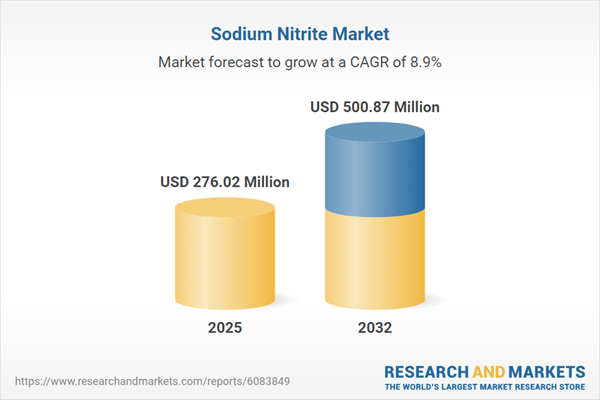Speak directly to the analyst to clarify any post sales queries you may have.
The sodium nitrite market stands at a crucial juncture, with its significance growing in manufacturing and industrial value chains. As regulatory frameworks tighten and supply chains adapt to new realities, leadership teams must approach this sector with enhanced strategic perspective and readiness to respond to ongoing shifts.
Sodium Nitrite Market Snapshot: Growth Trajectory and Industry Momentum
The sodium nitrite market advanced from USD 253.89 million in 2024 to USD 276.02 million in 2025, reflecting a robust 8.86% compound annual growth rate (CAGR). Projections place the market at USD 500.87 million by 2032, underpinned by expanding demand from food, chemical, and pharmaceutical sectors, accelerated infrastructure investments, and strategic realignment across supply networks. As market value climbs, organizations are urged to reassess their regional focus and operational frameworks to capture emerging opportunities.
Scope & Segmentation of the Sodium Nitrite Industry
This analysis addresses the entire sodium nitrite market landscape, providing actionable insights into each critical dimension shaping global demand and procurement:
- Applications: Includes corrosion inhibition, preservation in food systems (dairy, fish, poultry, meat), synthesis for pharmaceuticals and APIs, photographic chemical uses, textile dyeing, and formulation for water treatment across boiler and cooling systems.
- End Use Industries: Spans chemical manufacturing, food processing (encompassing bakery, dairy, confectionery, and meat), oil and gas, pharmaceuticals at both API and formulation levels, water treatment utilities, and textile production.
- Grade: Covers food grade, pharmaceutical grade, and technical grade sodium nitrite, each tailored to the purity and regulatory needs of their targeted sectors, enabling fit-for-purpose application across markets.
- Form: Delivered in formats such as flake, powder, granular, and solution, supporting ease of integration with diverse industrial processes.
- Distribution Channel: Available through direct sales, networked distributors, and online channels, adapting to the unique logistics and service requirements of each purchasing tier.
- Regions Covered: Comprehensive scope across Americas (North and Latin America), Europe, Middle East & Africa (including principal European, Middle Eastern, and African economies), and Asia-Pacific, with focused analysis on China, India, Japan, and emerging regional players.
Key Takeaways for Decision-Makers
- New manufacturing methods such as continuous flow reactors and advanced catalysts drive improvements in quality assurance and enhance cost-competitiveness for sodium nitrite producers.
- Regulatory demands, particularly concerning nitrosamine control, are prompting the sector to invest in real-time monitoring and higher purity standards, ensuring compliance across markets.
- Corporate sustainability objectives and resource optimization are shaping sodium nitrite sourcing policies and encouraging reuse or valorization of byproducts in line with circular economy best practices.
- Supply chain resilience grows as digital asset tracking and predictive analytics enable companies to build transparent, responsive, and traceable procurement strategies—critical under volatile conditions.
- Customized solutions in specialty sodium nitrite grades are opening new value pools, especially in premium pharmaceutical and food applications where high-margin opportunities are emerging.
Sodium Nitrite Market: Tariff Impact and Competitive Adaptations
Recent U.S. tariff policies have directly influenced global sourcing, cost structures, and trade balances for sodium nitrite. These changes are prompting companies to strengthen local production, consider nearshoring, and diversify supplier engagement. Flexible contracting models and advanced logistics planning are proving essential as procurement teams navigate shifting import and export landscapes. The ability to anticipate tariff-driven price and supply volatility is a distinguishing factor for sustained operational continuity.
Methodology & Data Sources for Sodium Nitrite Market Research
This study synthesizes insights from executive interviews, targeted field surveys, and exhaustive reviews of secondary sources including scientific journals, patent filings, regulatory documents, and official corporate disclosures. Data triangulation and internal quality assurance underpin the reliability of the sodium nitrite market outlook presented here.
Why This Sodium Nitrite Report Matters
- Empowers executive teams to make well-founded investment choices, highlighting the core drivers, emerging risks, and strategic levers unique to the sodium nitrite sector.
- Informs robust supply chain and procurement strategies by providing timely intelligence on regulatory transformations and shifting geographic supply patterns.
- Reveals key technology trends and collaborative opportunities influencing the sodium nitrite industry’s future direction and competitive landscape.
Conclusion
Ongoing changes in technology, regulation, and supply organization define the sodium nitrite market’s current landscape. Armed with targeted insight, senior leaders will be better positioned to manage complexity and foster long-term advantage within their organizations.
Table of Contents
3. Executive Summary
4. Market Overview
7. Cumulative Impact of Artificial Intelligence 2025
Companies Mentioned
The companies profiled in this Sodium Nitrite market report include:- Olin Corporation
- BASF SE
- Westlake Chemical Corporation
- Evonik Industries AG
- SNF S.A.
- Solvay SA
- Kemira Oyj
- China Petroleum & Chemical Corporation
- Yara International ASA
- Dow Inc.
Table Information
| Report Attribute | Details |
|---|---|
| No. of Pages | 187 |
| Published | October 2025 |
| Forecast Period | 2025 - 2032 |
| Estimated Market Value ( USD | $ 276.02 Million |
| Forecasted Market Value ( USD | $ 500.87 Million |
| Compound Annual Growth Rate | 8.8% |
| Regions Covered | Global |
| No. of Companies Mentioned | 11 |









